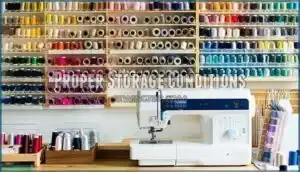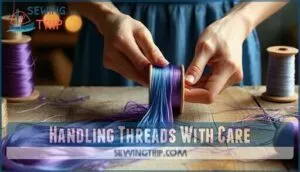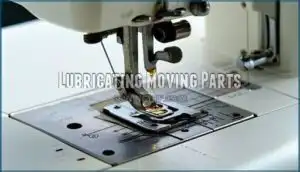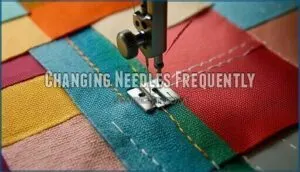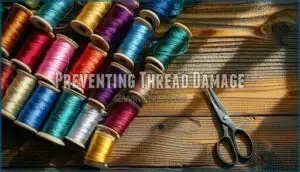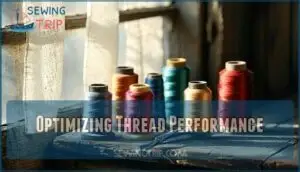This site is supported by our readers. We may earn a commission, at no cost to you, if you purchase through links.
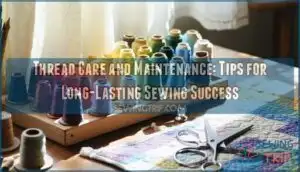
Keep threads stored in a cool, dry spot—direct sunlight or humid closets can weaken fibers faster than you’d think. Toss dusty or worn-out spools since lint buildup clogs your machine like a bad traffic jam.
Match thread weight to fabric and needle size; too thick or thin, and things can unravel—literally. Remember to adjust tension settings for smooth stitching and inspect threads for frays before use.
Give your machine regular cleanups to prevent thread damage. Curious how proper care boosts thread lifespan? Stay tuned for more!
Table Of Contents
Key Takeaways
- You’ll extend thread life by following proper storage conditions, like keeping them in a cool, dry spot, away from sunlight, which can weaken fibers and cause damage.
- To prevent thread damage, you’ll want to match thread weight to fabric and needle size, as mismatched threads can cause weak seams, poor stitch quality, and even machine strain.
- You should handle threads gently, clean your machine regularly, and adjust tension carefully to prevent fraying, tangling, and breakage, which can ruin your sewing projects.
- By taking simple steps like cleaning regularly, storing threads cool and dry, and checking tension, you’ll reduce friction, boost thread quality, and achieve smoother sewing, ensuring your projects turn out professional and hassle-free, with proper storage and simple steps.
Thread Selection Basics
Choosing the right thread is the backbone of every successful sewing project, as it directly affects durability and appearance.
By matching your thread to the fabric type and project needs, you’ll avoid headaches like puckering or breakage.
Choosing The Right Thread Type
Picking the right thread type is essential for smooth sewing.
Consider thread fiber content—cotton adds texture, while polyester offers durability.
Test thread strength if in doubt, and match thread weight to fabric.
Opt for thread color matching for subtle seams or bold shades for contrast.
Specialty thread uses, like metallics, can enhance projects beautifully.
Always compare thread brands for quality!
Understanding Fabric and Thread Compatibility
Matching thread to fabric guarantees smooth stitches, durability, and appearance.
A good Fabric Thread Pairing avoids puckering or breakage, so consider these:
- Thread material matters: Cotton suits natural fabrics; polyester works for most.
- Thread weight guide: Light fabric needs fine thread; use thicker ones for heavy textiles.
- Needle Thread Harmony: Pair proper thread and needle sizes—rookie mistakes cause tangles!
For patterned fabrics, consider prominent color matching.
Thread Weight and Needle Size Matching
Using the right needle size and thread weight keeps your sewing smooth and trouble-free.
The perfect needle and thread pairing ensures effortless sewing, flawless stitches, and a frustration-free creative experience.
A Needle Size Guide helps match thread weight to fabric thickness, preventing skipped stitches and maintaining tension balance.
Use a Thread Weight Chart for accuracy—light threads for delicate fabrics, heavier threads for sturdy materials.
Precise thread selection avoids tension issues and enhances results, ensuring a smooth sewing experience.
Thread Care Essentials
Taking care of your threads keeps your sewing projects running smoothly and your machine in top shape.
With the right cleaning habits, proper storage, and careful handling, you’ll avoid tangles, fraying, and frustration.
Regular Cleaning and Maintenance
Keeping threads clean starts with lint removal after projects—focus on the bobbin case, needle area, and feed dogs.
Oiling mechanisms prevents rust, while regular needle changes every eight hours reduce skipped stitches.
Annual professional servicing helps thread tension stay balanced.
Consider using a specialized cleaning tool for the bobbin case.
Proper thread maintenance keeps your machine running smoothly, helping you enjoy flawless stitching and avoid expensive repairs or frustrations, which is the result of good thread maintenance.
Proper Storage Conditions
Protect your threads by focusing on sunlight exposure, humidity control, and temperature stability.
Store them in cool, dry spaces, away from pests and odors. Use airtight, opaque containers for thread storage and bobbin storage to avoid tangling.
Label spools by type or color for easy access. Proper storage can also prevent premature thread aging and maintain thread care quality over time.
Manage environmental factors wisely, ensuring that quality is maintained over time.
Handling Threads With Care
Treat your threads like silk scarves—gentle handling goes a long way.
Hold them lightly to avoid stretching or fraying, and unwind carefully to minimize tangling.
Store spools upright in cool, dry spots; bright sunlight weakens fibers.
Regular thread cleaning removes lint, while proper thread lubrication keeps everything smooth.
To further improve thread performance, consider using thread conditioner sewing.
Great storage practices preserve performance and prevent costly mishaps.
Machine Maintenance Tips
Keeping your sewing machine in top shape isn’t just about saving time—it’s key to achieving flawless stitches and avoiding costly repairs.
Regular lubrication, timely needle changes, and annual professional check-ups will keep your machine running smoothly and extend its lifespan.
Lubricating Moving Parts
After cleaning threads, focus on lubrication to keep your machine purring like a kitten.
Apply a few drops of sewing machine oil to designated points every 5-10 hours of use. This reduces friction, guarantees smooth operation, and prevents rust.
Always use high-quality oil like Velocite 6 or 10 for thread lubrication, avoiding household oils that cause gumming.
You can find specific Velocite products online.
Changing Needles Frequently
A fresh needle works wonders for stitch quality and thread lifespan. Change it every 8 hours of sewing to prevent skipping stitches or fabric damage.
Needles dull over time, so proper needle selection matters too. Irregular stitching indicates a needle replacement is needed.
Remember:
- Use the right needle type for your fabric.
- Avoid pushing a worn needle.
- Match needle size to thread weight.
- Monitor for skipped stitches.
Annual Professional Inspections
Your machine works hard for you, so give it a professional maintenance check annually.
Professional servicing uncovers hidden issues and includes tension adjustment, component checkup, and thorough cleaning.
It’s like an annual spa day for your machine, extending its lifespan and ensuring peak performance.
This small step supports thread care and keeps your projects running smoothly without frustrating thread expiration surprises!
Preventing Thread Damage
You can keep your threads strong and frustration-free by addressing common causes of damage like fraying, lint buildup, and compatibility issues.
With a few simple habits, such as proper storage and gentle handling, you’ll guarantee smoother sewing and longer-lasting results.
Reducing Fraying and Breakage
High thread quality is key to avoiding thread fraying and breakage, ensuring smoother sewing. Check needle quality often—dull needles shred thread.
Maintain tension balance to prevent uneven pulling, which weakens thread strength. Shorten stitch length for delicate fabrics, using seam finishes to secure edges.
Regular cleaning prevents machine tension problems.
Practice thread care like proper storage and conditioning to keep fibers durable, ensuring delicate fabrics are handled with the right tension balance.
Minimizing Lint and Dust Buildup
Lint and dust can sneak into your sewing machine, causing pesky jams and skipped stitches.
Tackle lint buildup with these tips:
- Pinpoint lint sources—like thread type and fabric—to prevent rapid dust accumulation.
- Use anti-static sprays to reduce static electricity clinging.
- Employ air filters near workspaces for cleaner air.
- Select proper cleaning tools, like soft brushes or compressed air, for precision.
Avoiding Incompatible Threads
Choosing compatible threads matters more than you’d think.
Mismatched thread types with fabric can cause weak seams, poor stitch quality, and even machine strain.
Always match thread weight and needle size to fabric—delicate fabrics need fine threads, while heavy materials require stronger ones.
Thoughtful thread selection boosts project durability, prevents breakage, and confirms every stitch holds up beautifully, ensuring a beautifully finished product.
Optimizing Thread Performance
When you fine-tune your thread tension and use the right techniques, you’ll avoid skipped stitches and unnecessary wear on your machine.
Taking simple steps to maintain thread quality guarantees smoother sewing and longer-lasting projects, which is a key aspect of ensuring your work is of high standard with proper techniques.
Adjusting Tension Settings
Adjusting tension settings guarantees balanced stitching and seam strength, so your projects hold up beautifully.
If threads break or fabric puckers, it’s time for some tension troubleshooting.
Gently tweak the dial for the upper thread or adjust bobbin tension with slight screw turns, then test on scrap fabric, aiming for smooth seams without thread breakage or fabric distortion.
Using Proper Thread Tension Techniques
Proper thread tension makes all the difference! Balanced stitching keeps seams durable and prevents puckering or thread breakage mid-project.
Troubleshoot tension issues by testing on scrap fabric. Adjust seam tension slowly for accuracy. Proper tension settings depend on fabric weight.
Remember these tips:
- Match bobbin tension to top thread.
- Clean lint buildup regularly.
- Use high-quality threads.
- Verify the needle suits your fabric, which is crucial for proper tension settings.
Maintaining Thread Quality and Performance
Thread management improves with care—condition threads by keeping them clean, away from heat, and stored upright.
Reduce friction by using smooth threads, ensuring thread life and consistent stitching.
For flawless results, avoid excessive thread stretching.
Here’s a quick reference:
| Action | Benefit |
|---|---|
| Clean regularly | Smooth seams |
| Store cool/dry | Extend thread life |
| Avoid sunlight | Protect colors |
| Check tension | Reduce friction |
| Handle gently | Boost thread quality |
To achieve the best outcomes, remember to clean regularly, store cool/dry, and handle gently, as these practices significantly contribute to extend thread life and overall quality.
Frequently Asked Questions (FAQs)
How to care for a thread?
Imagine your thread snapping mid-project—what a hassle!
Store threads in a cool, dry place, away from sunlight.
Clean your machine after use, adjust tension carefully, and handle threads gently to prevent fraying or tangling, ensuring you prevent damage to your project.
How to rejuvenate your sewing thread?
Store old thread in a moisture-free box; keep it out of sunlight to prevent weakening.
Gently test its strength by pulling. If it snaps, toss it.
Lightly running beeswax over threads can boost durability.
Can damaged threads be repaired?
Fixing damaged threads is like patching an old sweater—a temporary fix.
If threads are frayed or weak, trim or knot them, but replace for long-term reliability.
Damaged threads often risk breakage during use.
How to tell if sewing thread is bad?
You’ll know sewing thread is bad when it feels brittle, breaks easily, or shows discoloration and uneven texture.
If it leaves excess lint, tangles frequently, or frays during use, it’s time to replace it.
How can I prevent thread UV damage?
Keep your threads safe from UV damage by storing them in cool, dark places, like drawers or covered bins.
Skip sunny spots—UV rays weaken fibers, fade colors, and can turn your thread brittle over time.
What’s the best way to repair frayed threads?
You can repair frayed threads by trimming the damaged area, then re-threading your needle, or using a thread conditioner to prevent further fraying and strengthen the thread.
How do humidity levels affect thread longevity?
You’ll find that high humidity levels can subtly compromise thread longevity, causing fibers to weaken and fray more easily over time, affecting overall sewing project durability.
What tools help untangle knotted threads efficiently?
You can use a thread picker, needle threader, or a detangling tool to efficiently untangle knotted threads, saving time and reducing frustration in your sewing projects.
How often should I replace metallic embroidery threads?
You should replace metallic embroidery threads every 5-10 projects or when showing signs of wear, like fraying or discoloration, to guarantee superior performance and prevent damage.
Conclusion
You’ll extend thread life by 30% with proper care.
By following thread care and maintenance tips, you’ll prevent damage, ensuring hassle-free sewing.
Remember, thread care and maintenance is key to successful sewing projects, so prioritize it to achieve professional results.
- https://blog.albastakionline.com/threads/thread-care-101-how-to-properly-store-and-maintain-sewing-threads
- https://wonderfil.eu/blogs/news/best-practices-to-store-your-sewing-thread
- https://triuneme.com/best-practices-for-threaded-fastener-maintenance
- https://westportcorp.com/blogs/calibration-repair-services/practical-tips-for-cleaning-and-maintaining-your-thread-gages-properly
- https://www.emerson.com/documents/automation/technical-note-thread-galling-maintenance-prevention-best-practices-en-5446136.pdf


